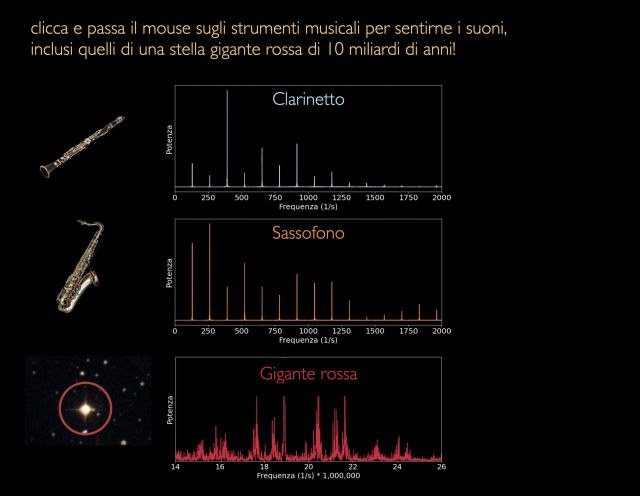How old is that star? Asteroseismology reveals the answer
The asteroseismic method, which studies “starquakes,” has been compared with traditional measurements based on the laws of gravity, confirming its reliability and accuracy in determining a star’s mass—and therefore its age
Credits: NSF / Daniel K. Inouye Solar Telescope, NASA / SDO / AIA, gpulse3d (Stéphane Charpinet)
It is possible to age and date a star by observing how it resonates. This has been demonstrated by an international research team led by scientists from the University of Bologna, who focused on a red giant—a star in an advanced evolutionary stage, with a radius about ten times that of the Sun—within an eclipsing binary system.
By observing the eclipses and the variations in velocity caused by the orbital motion of the two stars, the researchers determined the mass of the red giant using Newton’s law of universal gravitation.
Illustration of the eclipsing binary system KIC 10001167.
Left: the variation in light observed over time shows the periodic eclipses of the two stars. Right: the top-down view of the orbits of the two components (a red giant and a dwarf star), along with the variations in their velocities along the line of sight. By combining these data -light curves and radial velocities- astronomers can determine the stars’ masses with great precision.
At the same time, the researchers calculated the red giant’s mass -and therefore its age - using asteroseismology, a method that reveals stellar properties through the analysis of their natural resonances.
The results, published in Astronomy & Astrophysics, are striking: the two measurements of the star’s mass, one “traditional” and the other based on asteroseismology, differ by only 1.4%.
“For the first time, we were able to compare a seismic age estimate of a star with an independent measurement based on its orbit with a high level of accuracy,” says Jeppe Sinkbæk Thomsen, PhD student at the ‘Augusto Righi’ Department of Physics and Astronomy at the University of Bologna and first author of the study. “These results show that asteroseismology is a reliable method for measuring the mass and therefore the age of stars in our Galaxy.”
Measuring the mass of a solitary star in space is extremely challenging: If there are no companion stars orbiting it, it is impossible to use the “traditional” gravitational method. Asteroseismology offers the possibility of overcoming this limitation, as the approach relies solely on the measurement of tiny variations in brightness caused by waves reaching the surface of the star. These waves, or oscillations, provide valuable information about the internal structure of the star.
“Stars vibrate much like musical instruments: acoustic waves propagate within them, causing the entire structure to oscillate,” explains Andrea Miglio, professor at the ‘Augusto Righi’ Department of Physics and Astronomy at the University of Bologna and co-author of the study. “These oscillations resonate at different frequencies depending on the star’s internal properties, just as an instrument’s sound depends on its shape, size, and material. By studying these frequencies, we can determine a star’s mass and thus estimate its age".
On the left, we see a clarinet, a saxophone, and a red giant star, each one linked (in the center) to its own power spectrum — a sort of acoustic fingerprint showing how strongly it vibrates at different frequencies.
The star’s oscillations, originally occurring at around 20 microhertz (roughly one oscillation every 14 hours), have been multiplied by about 6.5 million to bring them into the audible range: the result is a 130 Hz tone, corresponding to C3, the same note played by the clarinet and saxophone in the animation.
Although the clarinet and saxophone both play the same fundamental note (C3), their spectra are different: this is their unique timbre, shaped by their form and internal structure. The same is true for stars: they also vibrate, and their internal oscillations produce tiny variations in brightness that we can measure with telescopes like Kepler.
By analyzing the star’s distribution of frequencies we can infer its mass, radius, and age.
Although the clarinet and saxophone both play the same fundamental note (C3), their spectra are different: this is their unique timbral signature, determined by their shape and internal structure. The same applies to stars: they also vibrate, and their internal oscillations produce subtle variations in brightness that we can measure with telescopes like Kepler.
By analyzing the distribution of these frequencies we can infer the mass, radius, and age of a star.
This results confirms the accuracy of the asteroseismic method, with implications that go far beyond dating a single star. This investigative technique makes it possible to analyze thousands of ancient stars in our galaxy, reconstructing the Milky Way’s evolution over billions of years.
The study has been published in Astronomy & Astrophysics with the title “Advancing the accuracy in age determinations of old-disk stars using an oscillating red giant in an eclipsing binary.” Authors from the University of Bologna include Jeppe Sinkbæk Thomsen, Andrea Miglio, Karsten Brogaard, Josefina Montalbán, Marco Tailo, Walter Eduard Van Rossem, and Massimiliano Matteuzzi from the ‘Augusto Righi’ Department of Physics and Astronomy.
Allegati




